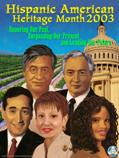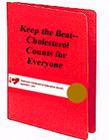
|
|
|
Cultural Link |


Topics of Interest In this IssueHispanic Heritage Month 9/15—10/15 Cholesterol Education Month Gynecologic Cancer Awareness Month
National Allied Health Week, 7—13
· · · · · · · National Marrow Awareness Month · National Allied Health Week, 7—13
|
|
SEPTEMBER QUESTION For all groups, lack of health insurance is associated with being more likely to have unmet health care needs. The Commonwealth Fund reported what percentage of adult Hispanics without health insurance at sometime during the past year? A. 82% B. 62% C. 42%
Email your response to nwosu@etsu.edu by 4:30 pm by September 25. The answer is found in a link in this month’s newsletter. A prize will be awarded to one winner, selected at random among those who submit the correct answer.
Answer to the August Question: The male/female ratio in the population is used to determine whether a country has “missing women.” The seven countries with the worst male-to-female sex ratios range, in descending order, from 1.92 to 1.22. See Table 1 in How gender (in)sensitive are the gender-related indices?
Did You Know?¨ The number of U.S. household residents who speak Spanish at home is about 31 million, 12% of U.S. household residents 5 years of age and over. Among those who speak Spanish at home, more than half say they speak English “very well.” American Factfinder
¨ About 1000 babies annually are born in the US with Sickle Cell Disease . The condition, most common in West and Central Africa, is also present in Portuguese, Spanish, French Corsicans, Sardinians, Sicilians, Italians, Greeks, Turks, Cypriots, Lebanese, Israeli, Saudi Arabian, Kuwaiti, Yemeni, Indian and Sri Lanka populations. Sickle Cell Disease Assoc. of America
|

Health Links on Diversity |
|
Article of the Month Flores uses a case study of a child acting as his own interpreter to highlight problems resulting from not using a trained interpreter with patients having limited proficiency in English. A single misinterpreted phrase can result in misdiagnosis, inappropriate treatment or patient misunderstanding about medication. Ad hoc interpreters in contrast to those who are trained, are more likely to make errors that have adverse clinical consequences. Other limitations of ad hoc interpreters are that they are unlikely to know medical terminology, are untrained in confidentiality issues, may have different priorities from the patient and may actually inhibit discussion of important but sensitive issues as domestic violence, substance, psychiatric illness or sexually transmitted diseases. The author supports passage of a California bill that would prohibit funding for organizations that use children younger than 15 as interpreters.
assessed annually for three years. The research took an ecological approach simultaneously studying multiple individual, family, and community risk and protective factors focused on occurrence of two types of abuse: severe physical assault and assault of child self-esteem.
|
|
The listing below represents just a few of the resources available to promote knowledge, awareness and discussions on diversity in health care among ETSU students, faculty and staff.
|
TOPIC TITLE & LOCATION |
|
September Newsletter References For more information or assistance contact Elaine Evans, Reference Assistant, COM Library,
For more information or assistance contact Elaine Evans, Reference Assistant, COM Library, evanse@etsu.edu. |
Other Observances in September |
|
September 2006 |





|
Hispanic Health
|
Free publication helps older Hispanics improve doctor/patient communication– Conversando con su médico. This free brochure is available at the ETSU Quillen College of Medicine Library Reference Department.
Health Insurance Beyond the Reach of Many U.S. Minorities– lack of health insurance, medical debt, and lack of confidence they could manage their chronic disease, were identified as serious access problems for Hispanics.
See the Fact Sheet on Latino Youth: Health Care Access for more on the impact of lack of health insurance coverage and other health access issues.
Hispanics Less Likely to Get bystander CPR– California study indicates that Hispanics in cardiac arrest received lifesaving CPR half as often as did Whites.
A new study shows that Mexican Americans at Higher Risk for Second Stroke– important information to consider to improve care. |
|
Cholesterol Education
|
Examples of Health Disparities related to high blood cholesterol and the national intervention strategies to reduce high cholesterol—cholesterol screening and encouraging adults to know their cholesterol numbers. Ethnic Differences in Achievement of Cholesterol Treatment Goals– This study examined possible reasons for why African Americans achieved less success in lowering their LDL-C than did non-Hispanic Whites. An important consideration in the discussion is non-compliance in following the doctor’s recommended treatment. Learn Your Cholesterol Number and other heart health education materials designed for different racial and ethnic populations, including an English-Spanish version. Links for use with screen readers for the blind. Take the Pledge for the 2006 National Cholesterol Education Month |
|
Sickle Cell Awareness
|
What is it like to have Sickle Cell Disease? An articulate young patient discusses school issues, dealing with pain, complications, relationships, skepticism of health care providers and advice for parents. FAQ’s about Sickle Cell Disease from health care professionals at the comprehensive Sickle Cell Site at Emory University Sickle Cell Information Center New Blood Test predicts Common and Severe Complication of Sickle Cell Disease—a hormone released by the heart ventricles in heart failure patients is found to be a marker for pulmonary hypertension in sickle cell patients. Who is affected by sickle cell disease? This disease extends beyond African Americans. Link to map showing world wide distribution. |
|
Gynecological Cancer Awareness
|
Uterine Cancer—Who’s at Risk?—describes who is at increased risk for gynecologic cancer and strategies for prevention. Cervical Cancer—disparities in screening, treatment and survival—article presents the health outcome disparities for cervical cancer, now a preventable disease in the US, highlighting the challenges of improving screening services for underserved populations. DC Area Program for Latinas Breaks Barriers to Cancer Screening—program removes language, cost and cultural barriers to cancer screening, helping their Hispanic patients return for annual screening exams. |
|
Labor Day Canada, USA 4
Suicide Prevention Week 10—16
Meskerem Egyptian/Ethiopian Coptics New Year Celebration
Rehabilitation Week 17—23
International Day of Peace
|
Rosh Hashana 22—24 Jewish New Year
Ramadan begins 23—10/22 Islam Month of Fasting
Heritage Day South Africa 24 Celebrating their diverse peoples and cultures
Prostate Cancer Awareness Month
Osteopathic Medicine Month
Alcohol & Drug Addiction Rehabilitation Month |
|
Arts, Cultural and Health Awareness Activities |
||
|
9/9 |
Carnegie Hotel |
|
|
9/11 |
409 Sherrod Library |
|
|
9/20 |
Borchuck Plaza |
|